Reaching out to your audience today is easy. Getting them to care about your brand and message?
That's the real challenge.
While social media marketing is excellent for outreach, nothing beats the power of hitting the inboxes of prospects and customers. And most marketers agree. In fact, 91% of B2B marketers rank email marketing as one of the most important content marketing channels for their organization.
This speaks volumes about email's impact on your organization’s reach and bottom line. But to get this level of performance, you have to learn how to improve your email open rate.
That's exactly what this article will teach you.
Subscribe to our weekly newsletter for tips so good that we might put ourselves out of business.
What is an email open rate & how do you calculate it?
Email open rate is a metric measuring the effectiveness of emails based on how many recipients open them.
To calculate email open rate, follow this formula:
Email open rate = Total number of emails opened / Total number of emails delivered x 100
For example, if 10 emails are delivered, but only 5 are opened, your email open rate is 50%. In other words:
5 total emails opened / 10 total emails delivered = .5 x 100 = 50% open rate
Your open rate goal will vary depending on your industry, niche, and several other factors. Still, I’m sure you still want to know what’s considered a good open email rate.
Let's review what open rates marketers are getting today below.
What is a good email open rate?
Your email open rate reflects how well you know your audience, mixed with external factors outside your control (like the economy and season).
Because of all these factors, it’s hard to really peg down a “good” open email rate.
So when setting a goal, consider the time of year and how others in your industry are faring. For example, benchmark reports show the average email open rate across all industries is 21.5%.
Want a more granular look? Here’s how average open rates vary from industry to industry:

Believe it or not, where you live also determines your potential email open rate. For example, Switzerland has a 29% open rate while the United Kingdom's average open rate is 13%.

How to improve email open rates (11 easy ways)
Feel like your email open rate could be better? You're not alone. Thankfully, there are tons of ways you can improve email open rates.
Here are 11 methods you can try today to get those emails opened and fortify your email marketing strategy.
1. Improve your email subject line
Email subject lines are possibly the most critical component in getting more clicks. It's what subscribers see first, and if it doesn't interest them, you can forget about increasing opens and conversions.
There are several ways to enhance your subject line and really stand out in the inbox.
Your first thought may be to use personalized subject lines with the recipient's name. While that definitely helps, one survey shows it may not boost the open rate by much.
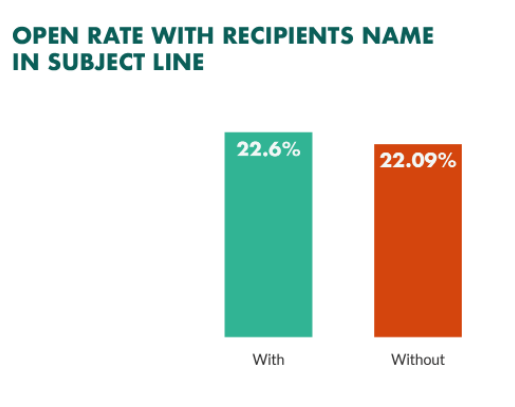
If not the recipient’s name, what about the length?
The same survey shows the length of subject lines matter. Those with six to 10 words appear to get the most action, making eight words a pretty safe bet.
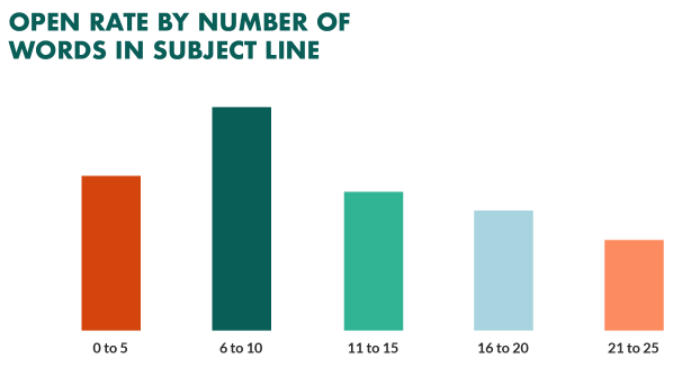
Besides personalization and length, you could A/B test the following:
- including emojis in the subject line
- using power words (e.g., “secret,” “save,” “exclusive,” etc.)
- asking a question and answering it in the email copy
- infusing a sense of urgency and FOMO
2. Create segmented lists
Sending a list of homes for sale to a list of subscribers who are already homeowners? Not good.
I mean…would you open an email that’s completely irrelevant to you?
These emails can also annoy the recipient and increase the odds of an unsubscription.
Segmentation is the best way to avoid this problem and ensure higher open rates. Make every email count and every email relevant to the specific audience segment that will receive them.
As you're developing audience segments, consider the interests, demographics, and other factors that make your audiences unique.
Having trouble segmenting? Simply ask your audience for feedback.
The Hustle does this by including an easy survey at the end of its newsletters:
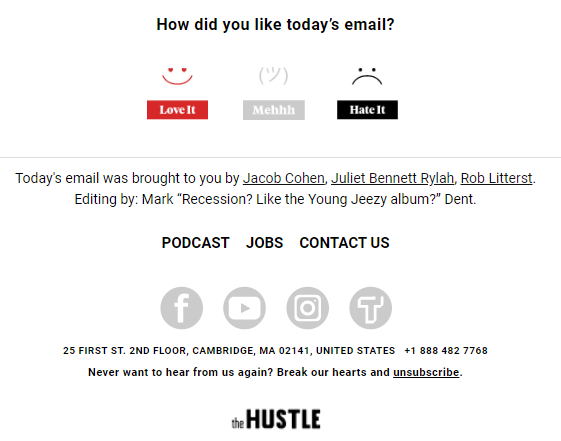
Similarly, TLDR Crypto asks subscribers to send comments and feedback as a direct response to the email:
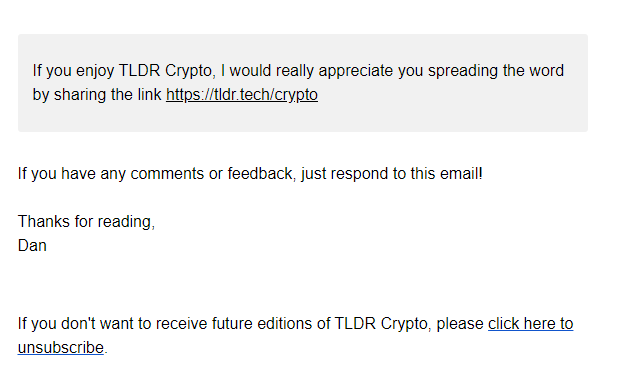
There’s no shame in asking your audiences for some insight. After all, your emails are for them.
Once you receive enough feedback, take what you learn to improve the email content and segmented lists you develop in the future.
3. Use a branded email address
Many small business owners and startups are guilty of using Gmail, Yahoo!, and other email service providers to send emails. This is a quick way to land in the spam folders of recipients.
Would you open an email from “johndoe@yahoo.com” advertising a one-day-only flash sale? Probably not.
Having a branded domain email address reduces the chances of your messages hitting that spam folder and increases the likelihood of getting an open. It looks professional and legitimate to recipients.
It doesn't cost much either. You can get a domain email from your web host or use Google Domain for an affordable annual price.
Also, the sender name is another way to build trust with recipients. One survey shows nearly 46% of consumers open emails based on who's sending them.
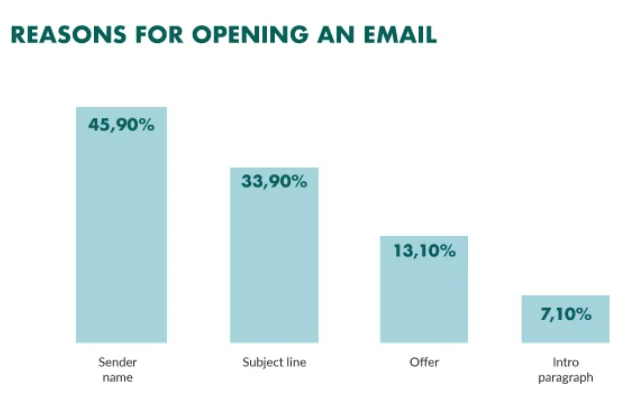
4. Avoid spammy language
Having a branded email is one way to look less spammy. But it won't always guarantee your emails get through spam filters. Using spammy language can also redirect your messages to the junk folder.
For example, avoid using generic terms like "valued client" or "sir." Instead, use the recipient's name or nothing if you don't have their name. Without the actual name, a simple salutation will suffice (e.g., “Hey there!” vs. “Hello, sir”).
To avoid sounding like spam,
- don’t sound too urgent (e.g., “Act now!” or “Do it today!”)
- don’t sound like a scam (e.g., “You’ve been selected!” or “Exclusive coupon prize for you!”)
- NEVER USE ALL CAPS OR A TON OF EXCLAMATION POINTS!!!!!!!
- don’t use superlatives (e.g., “The best you’ll ever see,” or “1,000 times better than…”)
- don’t sound too gimmicky (e.g., “You’re in luck,” or “Trust us, this isn’t spam.”)
This is especially true for eCommerce brands since they often send promotional emails.
Want a list of all the spammy language that can tank your open rates? HubSpot does a deeper dive with a list of 300+ spam trigger words to avoid.
5. Create high-quality content
Excellent spelling, grammar, and syntax will only get you so far. If your emails aren't engaging or conversational, you risk boring subscribers so much that they begin ignoring and deleting your messages.
To develop top-notch content and get the email opens you’re looking for, focus on crafting messages that resonate with your target audience(s), share the stories they want to hear, and combine them with an on-brand and effective email design.
For example, check out The Hustle’s newsletter email below:

6. Prioritize email design and layouts
The copy in your emails is essential. But it's hard to focus on the words if the look of the email itself is unappealing. So prioritize an excellent design and layout to create an experience the reader will trust will be exceptional every time they open one of your emails.
For example, use images to break up long text. Or even design HTML emails with nothing but visuals.
Whatever you decide, just keep in mind that the look you choose should resonate with your brand, purpose, and audience. (And don’t forget to A/B test your emails to find your winning formula.)
Let's say you're promoting a sale for your shoe department. Having an HTML design with shoe images and "Shop Now" CTA buttons is relevant and eye-catching.
Or take it a step further and add GIFs to capture attention, like the example below:
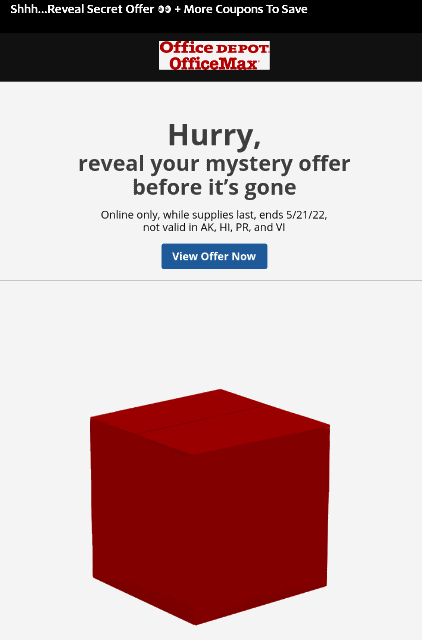
7. Get your send time right
Over 300 billion emails are sent and received every single day. So you can imagine the difficulties with inbox visibility.
There's a ton of competition, and if you send emails at the wrong time and/or on a wrong day, you risk falling into the abyss.
Various sources claim different optimal times to send emails, but it really comes down to your industry and subscriber base. So test frequently to see what works.
Meanwhile, you can use guidance from others who have already run tests.
One study shows the best day of the week is Monday for open rates.
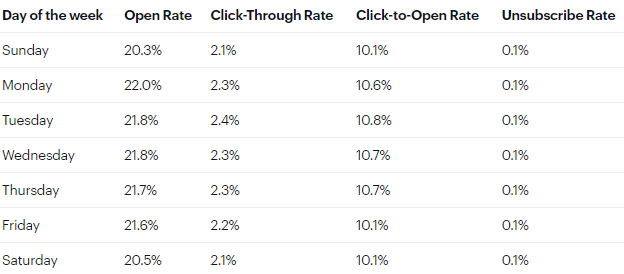
As for the time of day, 3 pm seems to be the best hour, followed by 12 pm and 6 pm. (If you have a global subscriber base, keep in mind their time zone.)
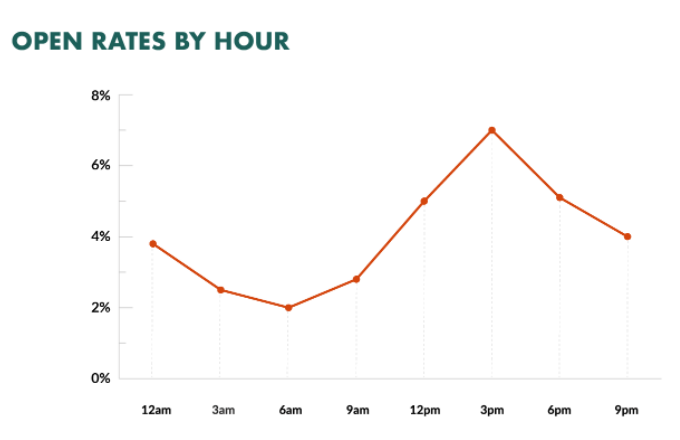
Bonus tip: Relying on manual email marketing leaves room for error—like not sending emails on time, sending them to the wrong segment, or forgetting to send them at all.
That’s not gonna help your open rates, will it?
These costly mistakes are easily avoidable by using an autoresponder series and email automation; it can help to ensure deliverability.
8. Remove the duds from your email list
You spent months or years building a list of email subscribers. The idea of kicking subscribers off your contact list seems blasphemous.
Until it’s not.
Think of it like this: you have hundreds (if not thousands) of fake or unresponsive emails on your list, hurting your email open rate. By removing them, you can instantly improve your email open rate.
Plus, it's more of an accurate depiction of how many active subscribers are engaging with your emails.
You can achieve this by
- removing anyone who doesn't open emails for a specific length of time
- segmenting people based on the emails they opened
- checking your subscriber list and pruning on a regular basis
Pro-tip: Some email automation tools like Mailchimp allow you to archive inactive subscribers without losing their data.
9. A/B test email campaigns
The best way to boost your email campaign performance and open rate is to run email A/B tests. How else would you know what works and doesn’t work?
You can split test
- different subject lines
- the use of personalization
- email body copy
- the placement and types of social proof
- preview text
- email designs
- + so much more
The more you test, the more you learn. But give it some time before taking the numbers as solid answers.
10. Use double opt-ins
Double opt-ins are annoying to some, but if a person truly wants to be on your email list, they'll do it. And if they're willing to complete the double opt-in, odds are they'll click on the emails you send.
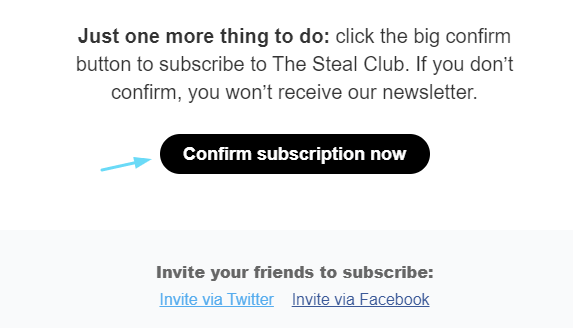
It’s like a small layer of security that has the ability to increase email open rates.
Why not go for the double opt-in?
11. Design with mobile phones in mind
Imagine spending hours designing a gorgeous email only to learn it looks horrible on a smartphone. You can’t overlook optimizing for mobile—not with the large number of people now using mobile phones to check emails.
After all, 81% of surveyed consumers use a smartphone to check emails.
Just look at how much mobile's grown since 2011:
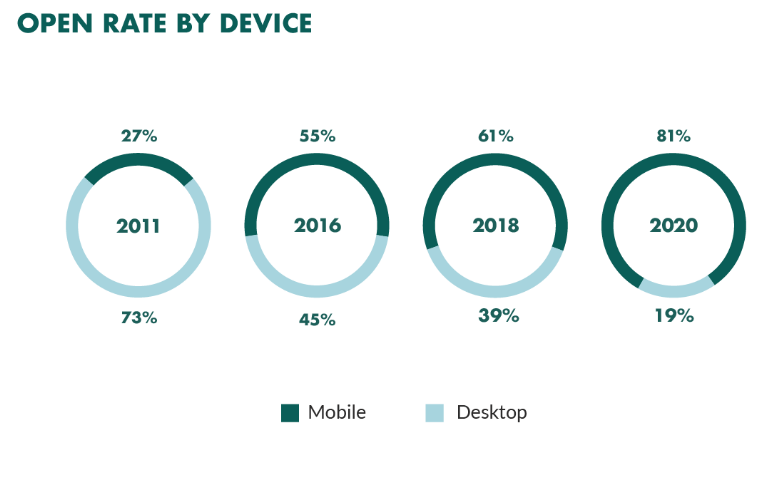
Make it a priority to design with mobile devices in mind to reduce low open rates and unsubscribes.
Several ways to improve your emails for mobile include
- using responsive templates
- keeping email subject lines short
- writing email copy that's concise
- compressing images
- breaking up the text
- using buttons over links (for the easy pressing)
Use these tips to get more email opens and clicks
We get it.
Spending time designing and writing emails only for folks to ignore them is disheartening. But don't allow it to hold back your email marketing campaigns.
With experimentation and feedback from your audience, you can learn what they're looking for from your brand and get the opens your emails deserve.
Until then, check out this guide with email marketing examples to inspire your next campaign and give you ideas for future optimizations.
